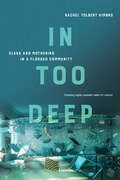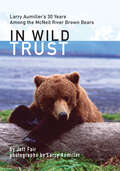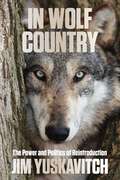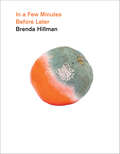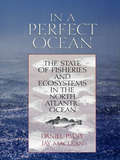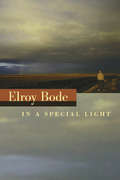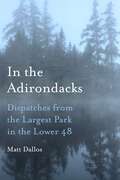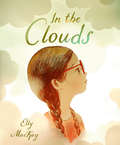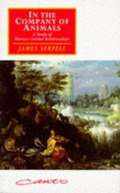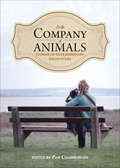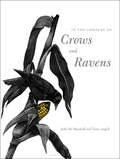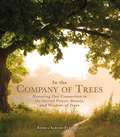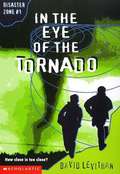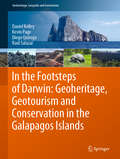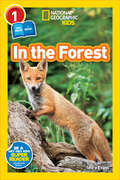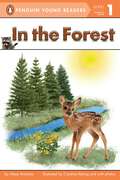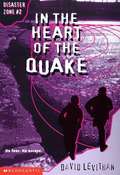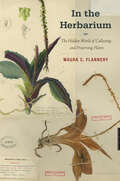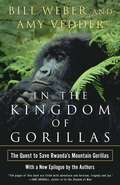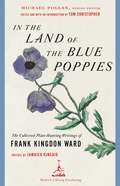- Table View
- List View
In Too Deep: Class and Mothering in a Flooded Community
by Rachel KimbroIn a small Texas neighborhood, an affluent group of mothers has been repeatedly rocked by catastrophic flooding—the 2015 Memorial Day flood, the 2016 Tax Day flood, and sixteen months later, Hurricane Harvey. Yet even after these disrupting events, almost all mothers in this neighborhood still believe there is only one place for them to live: Bayou Oaks.In Too Deep is a sociological exploration of what happens when climate change threatens the carefully curated family life of upper-middle-class mothers. Through in-depth interviews with thirty-six Bayou Oaks mothers whose homes flooded during Hurricane Harvey, Rachel Kimbro reveals why these mothers continued to stay in a place that was becoming more and more unstable. Rather than retreating, the mothers dug in and sustained the community they have chosen and nurtured, trying to keep social, emotional, and economic instability at bay. In Too Deep provides a glimpse into how class and place intersect in an unstable physical environment and underlines the price families pay for securing their futures.
In Wild Trust: Larry Aumiller's Thirty Years Among the McNeil River Brown Bears
by Jeff FairFor thirty years, Larry Aumiller lived in close company with the world’s largest grouping of brown bears, returning by seaplane every spring to the wilderness side of Cook Inlet, two hundred and fifty miles southwest of Anchorage to work as a manager, teacher, guide, and more. Eventually—without the benefit of formal training in wildlife management or ecology—he become one of the world’s leading experts on brown bears, the product of an unprecedented experiment in peaceful coexistence. This book celebrates Aumiller’s achievement, telling the story of his decades with the bears alongside his own remarkable photographs. As both professional wildlife managers and ordinary citizens alike continue to struggle to bridge the gap between humans and the wild creatures we’ve driven out, In Wild Trust is an inspiring account of what we can achieve.
In Wolf Country: The Power and Politics of Reintroduction
by Jim YuskavitchIn Wolf Country tells the story of the first groups of wolves that emigrated from reintroduced areas in Idaho to re-colonize their former habitat in the Pacific Northwest, how government officials prepared for their arrival, and the battles between the people who welcome them and the people who don&’t, set against the backdrop of the ongoing political controversy surrounding wolf populations in the Northern Rockies. The political maneuvering and intense controversy that has defined wolves&’ recovery in the West makes this a compelling and timely read.
In a Few Minutes Before Later (Wesleyan Poetry Series)
by Brenda HillmanFinalist for the Four Quartets Prize, given by Poetry Society of America, 2023An iconoclastic ecopoet who has led the way for many young and emerging artists, Brenda Hillman continues to re-cast innovative poetic forms as instruments for tracking human and non-human experiences. At times the poet deploys short dialogues, meditations or trance techniques as means of rendering inner states; other times she uses narrative, documentary or scientific materials to record daily events during a time of pandemic, planetary crisis, political and racial turmoil. Hillman proposes that poetry offers courage even in times of existential peril; her work represents what is most necessary and fresh in American poetry. During an enchantment in the lifeDo you love a living person absolutely? Tell them now.In a half-unwieldy life you made, underthe hyaline sky, while the dead drank from zigzag pools nearby,if they saved you in your wild incapacities, in timing of the world's harmin a little pettiness in your own heart while others took your madrigals in shreds to a tribunal, when others said you should feel grateful to be minimally adequate for the world'striple exposure or some tired committee... The ones who love us, how do theybreak through our defenses? We're tired today. Come back later.Their baffled voices melting our wax wallswith a candle, the ones who understandwhat being is—the glowing, the broken,the wheels, the brave ones— they have their courage,you have yours,,,; when you meet the one you love,it is so rare. When you meetthe one who loves you, it is extremely rare.
In a Perfect Ocean: The State Of Fisheries And Ecosystems In The North Atlantic Ocean (The State of the World's Oceans #1)
by Jay Maclean Daniel PaulyRecent decades have been marked by the decline or collapse of one fishery after another around the world, from swordfish in the North Atlantic to orange roughy in the South Pacific. While the effects of a collapse on local economies and fishing-dependent communities have generated much discussion, little attention has been paid to its impacts on the overall health of the ocean's ecosystems.In a Perfect Ocean: The State of Fisheries and Ecosystems in the North Atlantic Ocean presents the first empirical assessment of the status of ecosystems in the North Atlantic ocean. Drawing on a wide range of studies including original research conducted for this volume, the authors analyze 14 large marine ecosystems to provide an indisputable picture of an ocean whose ecology has been dramatically altered, resulting in a phenomenon described by the authors as "fishing down the food web." The book provides a snapshot of the past health of the North Atlantic and compares it to its present status; presents a rigorous scientific assessment based on key criteria; considers the factors that have led to the current situation; describes the policy options available for halting the decline; and offers recommendations for restoring the North Atlantic. This is the first in a series of assessments by the world's leading marine scientists, entitled "The State of the World's Oceans." In a Perfect Ocean: The State of Fisheries and Ecosystems in the North Atlantic Ocean is a landmark study, the first of its kind to make a comprehensive, ecosystem-based assessment of the North Atlantic Ocean, and will be essential reading for policymakers at the state, national, and international level concerned with fisheries management, as well for scientists, researchers, and activists concerned with marine issues or fishing and the fisheries industry.
In a Special Light
by Elroy BodeElroy Bode's books on nature and life have made him a favorite of readers and critics. Here he explores his home city of El Paso, the land and people of Central Texas, and his roles as teacher, father, and writer. These sharply observed, beautifully written pieces find the universal in the particular - a young boy in a barbershop, plaza life, a young couple in Smokey's Barbecue. In a Special Light discovers pleasure in the lives of ordinary people, and joy in the worlds in which they live.
In a Special Light
by Elroy BodeElroy Bode's books on nature and life have made him a favorite of readers and critics. Here he explores his home city of El Paso, the land and people of Central Texas, and his roles as teacher, father, and writer. These sharply observed, beautifully written pieces find the universal in the particular - a young boy in a barbershop, plaza life, a young couple in Smokey's Barbecue. In a Special Light discovers pleasure in the lives of ordinary people, and joy in the worlds in which they live.
In the Adirondacks: Dispatches from the Largest Park in the Lower 48
by Matt DallosAn immersive journey into the past, present, and future of a region many consider the Northeast’s wilderness backyard. Out of all the rural areas of the United States, including those in the West, which are bigger and propped up by more pervasive myths about adventure and nation and wilderness and freedom, the Adirondacks has accumulated a well-known identity beyond its boundaries. Untouched, unspoiled, it is defined by what we haven’t done to it. Combining author Matt Dallos’s personal observations with his thorough research of primary and secondary documents, In the Adirondacks rambles through the region to understand its significance within American culture and what lessons it might offer us for how we think about the environment. In vivid prose, Dallos digs through the region’s past and present to excavate a series of compelling stories and places: a moose named Harold, a hot dog mogul’s rustic mansion, an ecological restoration on an alpine summit, a hermit who demanded a helicopter ride, and a millionaire who dressed up as a Native American to rob a stagecoach. Along the way, Dallos listens to locals and tourists, visits wilderness areas and souvenir shops, and digs through archives in museums and libraries.In the Adirondacks blends lively history and immersive travel writing to explore the Adirondacks that captivated Dallos’s childhood imagination while presenting a compelling and entertaining story about America’s largest park outside of Alaska. The result is an inquisitive journey through the region’s bogs and lakes and boreal forests and the lives of residents and tourists. Dallos turned toward the region to understand why he couldn’t shake it from his mind. What he learned is that he’s not the only one.In the Adirondacks explores the history and future of the most complicated, contested park in North America, raising important questions about the role of environmental preservation and the great outdoors in American history and culture.
In the Clouds
by Elly MacKayA luminous journey into the sky for daydreamers and cloud enthusiasts big and small, from renowned paper-diorama artist Elly MacKay.A bored and curious little girl wishes for a bit of sunshine on a cloudy day. But a friendly bird soon whisks her off for an adventure in the sky, where she can contemplate questions both scientific and philosophical in nature: how do clouds float? Or carry the rain? Where do they go when they disappear? Are there clouds on other planets? Do they have memories? Have they ever seen a girl like her?This dreamy picture book from the inimitable Elly MacKay features her trademark stunning, light-infused spreads that beautifully capture the wondrousness of clouds and the power of nature to inspire and stimulate imaginations.
In the Company of Animals: A study of human-animal relationships
by James SerpellIn the Company of Animals is an original and very readable study of human attitudes to the natural world. It contrasts the way we love some animals while ruthlessly exploiting others; it provides a detailed and fascinating account of ways in which animal companionship can influence our health; and it provides a key to understanding the moral contradictions inherent in our treatment of animals and nature. Its scope encompasses history, anthropology, and animal and human psychology. Along the way, the author uncovers a fascinating trail of insights and myths about our relationship with the species with which we share the planet. James Serpell is the editor of The Domestic Dog: Its Evolution, Behavior and Interactions With People (CUP, 1995).
In the Company of Animals: Stories of Extraordinary Encounters
by Edited by Pam ChamberlainReal-life tales that explore the complexities of human-animal relationships—from domestic pets to farm animals to wildlife.In this collection, thirty-seven writers from across Canada tell thought-provoking stories of extraordinary encounters with a variety of animals—from rats and salamanders to wolves and bears. From tributes to a favorite cat or dog to tales of a chance encounter with a moose or a cougar, these stories are sure to entertain and enlighten. The writers are people who spend time in the company of animals—pet owners, farmers, veterinarians, hunters, artists, landowners, game wardens—those who pay close attention to them and their natures, and the lessons they can teach us.
In the Company of Crows and Ravens
by John M. Marzluff Tony Angell"Crows and people share similar traits and social strategies. To a surprising extent, to know the crow is to know ourselves."--from the Preface From the cave walls at Lascaux to the last painting by Van Gogh, from the works of Shakespeare to those of Mark Twain, there is clear evidence that crows and ravens influence human culture. Yet this influence is not unidirectional, say the authors of this fascinating book: people profoundly influence crow culture, ecology, and evolution as well. John Marzluff and Tony Angell examine the often surprising ways that crows and humans interact. The authors contend that those interactions reflect a process of "cultural co-evolution." They offer a challenging new view of the human-crow dynamic--a view that may change our thinking not only about crows but also about ourselves. Featuring more than 100 original drawings, the book takes a close look at the influences people have had on the lives of crows throughout history and at the significant ways crows have altered human lives. In the Company of Crows and Ravens illuminates the entwined histories of crows and people and concludes with an intriguing discussion of the crow-human relationship and how our attitudes toward crows may affect our cultural trajectory.
In the Company of Trees: Honoring Our Connection to the Sacred Power, Beauty, and Wisdom of Trees
by Andrea Sarubbi FereshtehFascinating facts, trivia, and stories celebrating nature and the magnificent life of trees and their invaluable place in our lives, including beautiful, full-color photographs throughout.When was the last time you spent time outside? The space between your front door and your car doesn’t count. Nature holds incredible power to soothe our spirits, calm our minds, and open us up to creativity, if we can unplug long enough to step away from our screens and embrace it. And while they say you can’t see the forest for the trees, they play perhaps the leading role in our enjoyment of the outdoors. In the Company of Trees helps you rediscover your own connection to the world outside, with over 195 quotes, facts, and stories honoring trees from across the world and in our own back yards alike. Inviting, full-color photos of sun-dappled forests and tree-filled hikes throughout will inspire you to do some forest-bathing of your own and embrace the healing power of nature.
In the Event of Love: A sweet and steamy Christmas rom-com! (Fern Falls)
by Courtney KaeGoodreads Summer Romance Reading RecommendationBuzzfeed's Most Anticipated LGBTQ Romances of 2022'Exactly the slow-burn, second-chance, friends-to-lovers romance I was craving' ALI HAZELWOOD'The perfect holiday romance! . . . Move over, Stars Hollow. I'm moving to Fern Falls!' Lacie Waldon'The holiday romance of my dreams! The sweetness of a Hallmark holiday movie, set in a town that rivals Schitt's Creek, with plenty of steamy scenes to heat things up!' Falon Ballard'Wintry perfection, a cozy flannel blanket of a book that wraps its reader in the warmest hug' Rachel Lynn SolomonOffering a steamy, queer spin on the feel-good tropes Hallmark movie, this sweet, funny #OwnVoices rom-com is perfect for fans of Casey McQuiston and Alexandria Bellefleur!......................................... With her career as a successful Los Angeles event planner imploding, Morgan Ross isn't just heading home for the holidays, it's more of a strategic retreat. Breathtaking mountain backdrops, acres of pine trees, quirky townsfolk, and charming small businesses aside, Fern Falls is also the setting of Morgan's greatest heartbreak - and she'll do anything to avoid her one-time best friend turned first love, Rachel Reed. But when Morgan discovers that Rachel's struggling Christmas tree farm is the only thing standing between Fern Falls and a corporate takeover, she has to put her heartbreak on hold. Pouring her focus into planning the perfect Christmas event to save the town, Morgan finds herself spending more and more time with Rachel. Who can blame them if the romance of the season starts to get to them? Morgan knows one thing for sure though: she and Rachel will never have a heart-warming happy ending. And, anyway, she's only here for Christmas . . . right? .........................................'Sparkles with humor and charm. The residents of Fern Falls will draw you in with their warm banter and open hearts, while the sapphic romance will heat you up faster than a cup of hot cocoa on a snowy day' Sonia Hartl'Will make your heart soar. A sexy, sparkling debut' Annette Christie'Reads like a Hallmark Christmas movie and goes down like a mug of peppermint hot chocolate... Cozy, comforting, and surprisingly steamy - this is the queer Christmas story we deserve!' Alison Cochrun'Sweet as a cup of hot cocoa (with some spice mixed in) . . . the feel-good, queer, second-chance holiday romance we've all been waiting for' Anita Kelly'Kae's sparkling voice wraps you up like a warm blanket' Ava Wilder'Ultra cozy, heart-meltingly sweet, and full of warm wit. Courtney Kae shines with a fresh, bright voice and supremely relatable characters including a dreamy lumberjane who instantly stole my heart!' Rosie Danan'With its charming small town, snowy mountaintop kisses, and dreamy lesbian lumberjane, In the Event of Love is perfect for the holidays!' Helen Hoang
In the Eye of the Tornado
by David LevithanStieg Atwood has the Sense. He can tell when natural disasters are going to hit. Now, with his parents dead, Stieg and his brother Adam must save people before disasters strike -- like the twister that's guaranteed to hit somewhere soon.
In the Footsteps of Audubon
by Denis ClavreulAn artist’s uniquely personal journey across AmericaIn the nineteenth century, ornithologist and painter John James Audubon set out to create a complete pictorial record of North American birdlife, traveling from Louisiana and the Florida Keys to the Gulf of Saint Lawrence and the cliffs of the Yellowstone River. The resulting work, The Birds of America, stands as a monumental achievement in American art. Over a period of sixteen years, recording his own journey in journals and hundreds of original paintings, renowned French watercolorist Denis Clavreul followed in the naturalist’s footsteps.In the Footsteps of Audubon brings together some 250 of Clavreul’s stunning watercolors along with illuminating selections from Audubon’s journals and several of his paintings. With pencil and brush in hand, Clavreul turns his naturalist’s eye and painterly skill to the landscapes that Audubon encountered on his travels, and to the animals and plants that Audubon depicted in his art. A passionate ornithologist, Clavreul sketches birds in the wild with rare dexterity, bringing them vividly to life on the page. He documents his encounters along the way with people who live with nature, many of whom are passionately engaged in preserving it, drawing on his insights as both a biologist and an artist to connect the past, present, and future.A spellbinding, richly evocative journey, In the Footsteps of Audubon is an invitation to see the natural world as Audubon saw it—and to see with new eyes what it has become today.
In the Footsteps of Darwin: Geoheritage, Geotourism and Conservation in the Galapagos Islands (Geoheritage, Geoparks and Geotourism)
by Kevin Page Diego Quiroga Daniel Kelley Raul SalazarThis book provides the first-ever overview of and guide to the geological setting and related features of the famous, volcanically active Galapagos Islands, as well as an in-depth analysis of the setting’s relationship to the region’s unique and iconic ecology, and its conservation. Further, it provides an introduction to human settlement and activity on the islands, including the transition from subsistence to a fishing economy and more recently tourism, all in the context of increasingly restrictive conservation regulations. Importantly, the book also explores the development of the concept and practice of sustainable development across the islands as a framework for future economic development, pursuing an approach that reconciles the needs of the resident population with conservation of this fragile environment.The book is intended for a broad readership, from those engaged in geological and ecological studies, college and university educators and conservation practitioners, to more general visitors to the islands.
In the Forest (National Geographic Kids Readers)
by Shira EvansWhat kinds of interesting critters live amongst the forest trees? Adult and child readers can find out together in this new Level 1 co-reader from National Geographic Kids, full of engaging photos and fun facts.
In the Forest (Penguin Young Readers, Level 1)
by Alexa AndrewsLearn all about what lives and grows in the forest in the three stories of this Level 1 nonfiction reader. Deer and other wildlife, trees and other plant life, and much more are found In the Forest!
In the Garden with Dr. Carver
by Nicole Tadgell Susan GrigsbySally is a young girl living in rural Alabama in the early 1900s, a time when people were struggling to grow food in soil that had been depleted by years of cotton production. One day, Dr. George Washington Carver shows up to help the grownups with their farms and the children with their school garden. He teaches them how to restore the soil and respect the balance of nature. He even prepares a delicious lunch made of plants, including "chicken" made from peanuts. And Sally never forgets the lessons this wise man leaves in her heart and mind. Susan Grigsby's warm story shines new light on an African American scientist who was ahead of his time.
In the Heart of the Quake
by David LevithanA quake is coming, and it's tearing Stieg apart. He doesn't know when it will hit, but he knows it will be a big one -- in San Francisco.
In the Herbarium: The Hidden World of Collecting and Preserving Plants
by Maura C. FlanneryHow herbaria illuminate the past and future of plant science Collections of preserved plant specimens, known as herbaria, have existed for nearly five centuries. These pressed and labeled plants have been essential resources for scientists, allowing them to describe and differentiate species and to document and research plant changes and biodiversity over time—including changes related to climate. Maura C. Flannery tells the history of herbaria, from the earliest collections belonging to such advocates of the technique as sixteenth-century botanist Luca Ghini, to the collections of poets, politicians, and painters, and to the digitization of these precious specimens today. She charts the growth of herbaria during the Age of Exploration, the development of classification systems to organize the collections, and herbaria&’s indispensable role in the tracking of climate change and molecular evolution. Herbaria also have historical, aesthetic, cultural, and ethnobotanical value—these preserved plants can be linked to the Indigenous peoples who used them, the collectors who sought them out, and the scientists who studied them. This book testifies to the central role of herbaria in the history of plant study and to their continued value, not only to biologists but to entirely new users as well: gardeners, artists, students, and citizen-scientists.
In the King's Name
by Alexander KentFilled with high-seas intrigue and sharp tensions, this nautical novel takes an intense voyage into the heart of Napoleonic-era Africa. The year is 1819 and Captain Adam Bolitho has been sent on an urgent but risky mission to make a fast passage from Plymouth to Freetown, West Africa, with secret orders for the senior officer stationed there. Due to the slave trade being declared illegal, ships in every harbor are waiting to be scrapped and officers have been cut loose without hope of future commands, thus Adam soon finds himself the object of envy and jealousy. In Africa he discovers unexpected allies and faces an enemy far more powerful and ruthless than any he has known before.
In the Kingdom of Gorillas: The Quest to Save Rwanda's Mountain Gorillas
by Bill Weber Amy VedderFrom the founders of the world-famous Mountain Gorilla Project, an empowering account of their efforts to save the mountain gorilla in Rwanda and how they succeeded—even in the midst of a horrendous civil war.In 1978, when Dr. Bill Weber and Dr. Amy Vedder arrived in Rwanda to study mountain gorillas with Dian Fossey, the gorilla population was teetering toward extinction. Poaching was rampant, but it was loss of habitat that most endangered the gorillas. When yet another slice of the Virunga Mountains was targeted for development, Weber and Vedder recognized that the gorillas were doomed unless something was done to save their land. Over Fossey's objections, they helped found the Mountain Gorilla Project. The MGP was designed to educate Rwandans about the gorillas and about the importance of conservation, while at the same time establishing an ecotourism project—one of the first anywhere in a rainforest—to bring desperately needed revenue to Rwanda. In vivid detail, Weber and Vedder describe their experiences getting to know entire families of gorillas, from powerful silverback patriarchs to helpless newborn infants. They tell us about the gorillas they recognized and came to know as individuals, stories both tragic and joyful. They describe a landscape that was heaven one day, green hell the next. And they tell of their discovery of the terrible and mysterious events surrounding Fossey's murder. They explain that the key to saving the mountain gorillas was helping the people of Rwanda—even in the face of a civil war—to share in the benefits of conservation. Rich with details about the gorillas' lives, the realities of conservation, and portraits of ordinary people caught in extraordinary times, this is a riveting adventure story that is sure to take its place among the classic accounts of the world of nature.
In the Land of the Blue Poppies: The Collected Plant-Hunting Writings of Frank Kingdon Ward (Modern Library Gardening)
by Jamaica Kincaid Tom Christopher Frank Kingdon WardA Modern Library Paperback OriginalDuring the first years of the twentieth century, the British plant collector and explorer Frank Kingdon Ward went on twenty-four impossibly daring expeditions throughout Tibet, China, and Southeast Asia, in search of rare and elusive species of plants. He was responsible for the discovery of numerous varieties previously unknown in Europe and America, including the legendary Tibetan blue poppy, and the introduction of their seeds into the world's gardens. Kingdon Ward's accounts capture all the romance of his wildly adventurous expeditions, whether he was swinging across a bottomless gorge on a cable of twisted bamboo strands or clambering across a rocky scree in fear of an impending avalanche. Drawn from writings out of print for almost seventy-five years, this new collection, edited and introduced by professional horticulturalist and House & Garden columnist Tom Christopher, returns Kingdon Ward to his deserved place in the literature of discovery and the literature of the garden.
